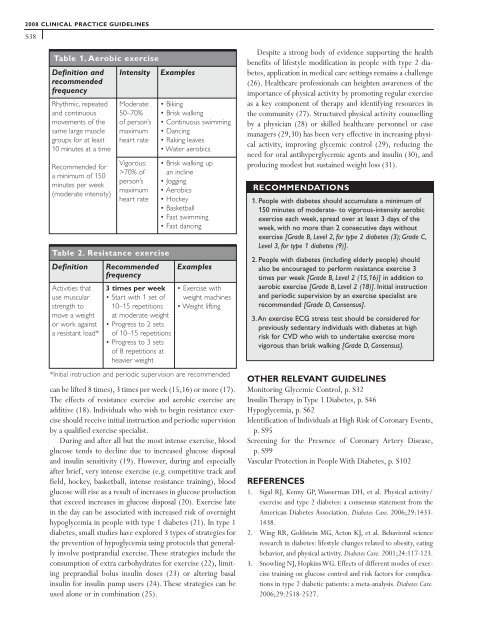2008 Clinical Practice Guidelines - Canadian Diabetes Association
2008 Clinical Practice Guidelines - Canadian Diabetes Association
2008 Clinical Practice Guidelines - Canadian Diabetes Association
Create successful ePaper yourself
Turn your PDF publications into a flip-book with our unique Google optimized e-Paper software.
<strong>2008</strong> CLINICAL PRACTICE GUIDELINES<br />
S38<br />
Table 1. Aerobic exercise<br />
Definition and<br />
recommended<br />
frequency<br />
Rhythmic, repeated<br />
and continuous<br />
movements of the<br />
same large muscle<br />
groups for at least<br />
10 minutes at a time<br />
Recommended for<br />
a minimum of 150<br />
minutes per week<br />
(moderate intensity)<br />
Table 2. Resistance exercise<br />
Definition Recommended<br />
frequency<br />
Activities that<br />
use muscular<br />
strength to<br />
move a weight<br />
or work against<br />
a resistant load*<br />
Intensity Examples<br />
Moderate:<br />
50–70%<br />
of person’s<br />
maximum<br />
heart rate<br />
Vigorous:<br />
>70% of<br />
person’s<br />
maximum<br />
heart rate<br />
3 times per week<br />
• Start with 1 set of<br />
10–15 repetitions<br />
at moderate weight<br />
• Progress to 2 sets<br />
of 10–15 repetitions<br />
• Progress to 3 sets<br />
of 8 repetitions at<br />
heavier weight<br />
• Biking<br />
• Brisk walking<br />
• Continuous swimming<br />
• Dancing<br />
• Raking leaves<br />
• Water aerobics<br />
• Brisk walking up<br />
an incline<br />
• Jogging<br />
• Aerobics<br />
• Hockey<br />
• Basketball<br />
• Fast swimming<br />
• Fast dancing<br />
Examples<br />
• Exercise with<br />
weight machines<br />
• Weight lifting<br />
*Initial instruction and periodic supervision are recommended<br />
can be lifted 8 times), 3 times per week (15,16) or more (17).<br />
The effects of resistance exercise and aerobic exercise are<br />
additive (18). Individuals who wish to begin resistance exercise<br />
should receive initial instruction and periodic supervision<br />
by a qualified exercise specialist.<br />
During and after all but the most intense exercise, blood<br />
glucose tends to decline due to increased glucose disposal<br />
and insulin sensitivity (19). However, during and especially<br />
after brief, very intense exercise (e.g. competitive track and<br />
field, hockey, basketball, intense resistance training), blood<br />
glucose will rise as a result of increases in glucose production<br />
that exceed increases in glucose disposal (20). Exercise late<br />
in the day can be associated with increased risk of overnight<br />
hypoglycemia in people with type 1 diabetes (21). In type 1<br />
diabetes, small studies have explored 3 types of strategies for<br />
the prevention of hypoglycemia using protocols that generally<br />
involve postprandial exercise.These strategies include the<br />
consumption of extra carbohydrates for exercise (22), limiting<br />
preprandial bolus insulin doses (23) or altering basal<br />
insulin for insulin pump users (24). These strategies can be<br />
used alone or in combination (25).<br />
Despite a strong body of evidence supporting the health<br />
benefits of lifestyle modification in people with type 2 diabetes,<br />
application in medical care settings remains a challenge<br />
(26). Healthcare professionals can heighten awareness of the<br />
importance of physical activity by promoting regular exercise<br />
as a key component of therapy and identifying resources in<br />
the community (27). Structured physical activity counselling<br />
by a physician (28) or skilled healthcare personnel or case<br />
managers (29,30) has been very effective in increasing physical<br />
activity, improving glycemic control (29), reducing the<br />
need for oral antihyperglycemic agents and insulin (30), and<br />
producing modest but sustained weight loss (31).<br />
RECOMMENDATIONS<br />
1. People with diabetes should accumulate a minimum of<br />
150 minutes of moderate- to vigorous-intensity aerobic<br />
exercise each week, spread over at least 3 days of the<br />
week, with no more than 2 consecutive days without<br />
exercise [Grade B, Level 2, for type 2 diabetes (3); Grade C,<br />
Level 3, for type 1 diabetes (9)].<br />
2. People with diabetes (including elderly people) should<br />
also be encouraged to perform resistance exercise 3<br />
times per week [Grade B, Level 2 (15,16)] in addition to<br />
aerobic exercise [Grade B, Level 2 (18)]. Initial instruction<br />
and periodic supervision by an exercise specialist are<br />
recommended [Grade D, Consensus].<br />
3.An exercise ECG stress test should be considered for<br />
previously sedentary individuals with diabetes at high<br />
risk for CVD who wish to undertake exercise more<br />
vigorous than brisk walking [Grade D, Consensus].<br />
OTHER RELEVANT GUIDELINES<br />
Monitoring Glycemic Control, p. S32<br />
Insulin Therapy in Type 1 <strong>Diabetes</strong>, p. S46<br />
Hypoglycemia, p. S62<br />
Identification of Individuals at High Risk of Coronary Events,<br />
p. S95<br />
Screening for the Presence of Coronary Artery Disease,<br />
p. S99<br />
Vascular Protection in People With <strong>Diabetes</strong>, p. S102<br />
REFERENCES<br />
1. Sigal RJ, Kenny GP, Wasserman DH, et al. Physical activity/<br />
exercise and type 2 diabetes: a consensus statement from the<br />
American <strong>Diabetes</strong> <strong>Association</strong>. <strong>Diabetes</strong> Care. 2006;29:1433-<br />
1438.<br />
2. Wing RR, Goldstein MG, Acton KJ, et al. Behavioral science<br />
research in diabetes: lifestyle changes related to obesity, eating<br />
behavior, and physical activity. <strong>Diabetes</strong> Care. 2001;24:117-123.<br />
3. Snowling NJ, Hopkins WG. Effects of different modes of exercise<br />
training on glucose control and risk factors for complications<br />
in type 2 diabetic patients: a meta-analysis. <strong>Diabetes</strong> Care.<br />
2006;29:2518-2527.











